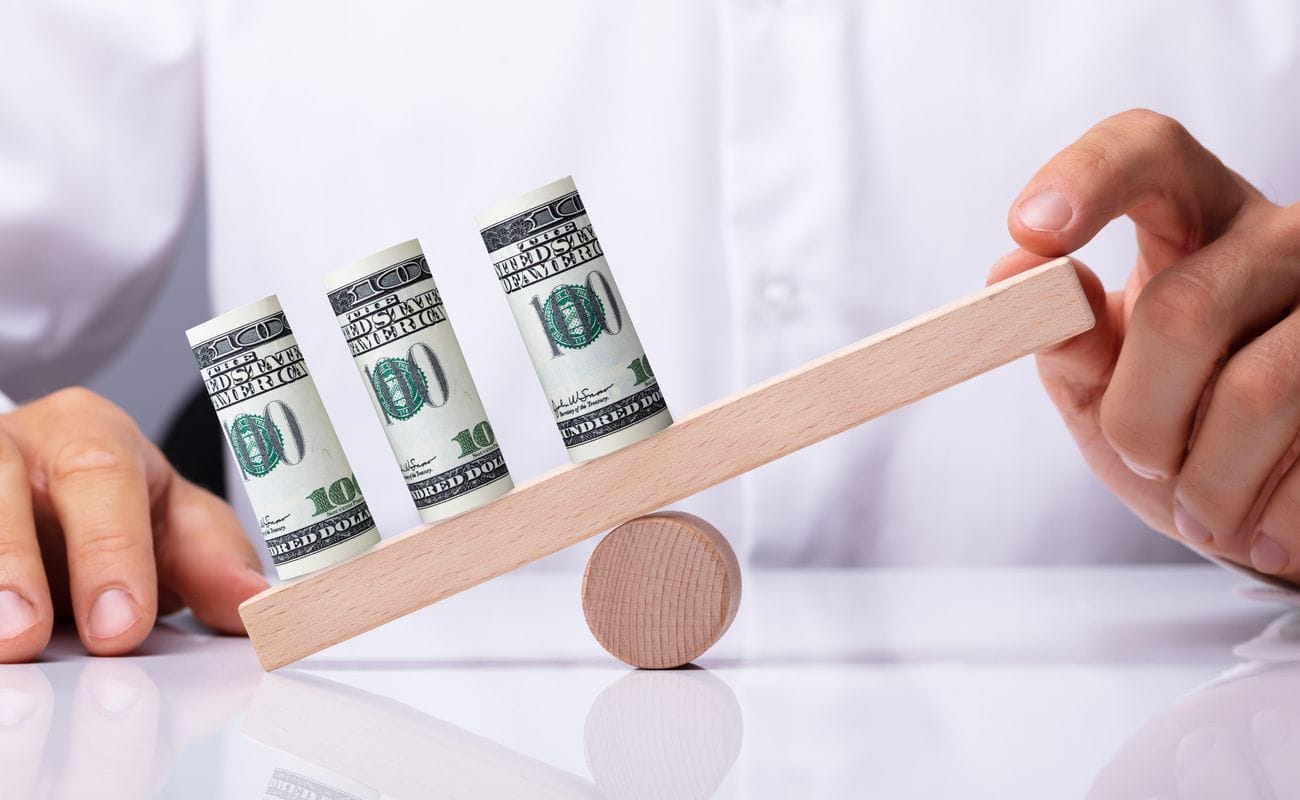
When it comes to casino, live dealer or sports betting, the aim of the game is to play the odds and win by placing bets. Unfortunately, many people who dabble in betting don’t understand the best way to manage their spending when it comes to gambling. Understanding responsible betting can be the difference between having a lot of fun or harming your personal finances. This is why it’s so important to know how to manage your bankroll.
We unpack the concept of a bankroll, how to set one up, the different strategies to build it, manage it and protect it from being lost and bet with your bankroll wisely.
What is a bankroll?
The simple definition of a bankroll is that it’s an amount of money you set aside to use for betting and gambling. You play only with the money you’ve set aside in your bankroll to avoid any financial issues. Learning to manage your bankroll could be the difference between losing all your savings and having fun and making money. It is a key element of responsible gambling habits.
To ensure that gambling is a rewarding experience, it is in your best interest to set up a bankroll. In that way, you acknowledge the risks involved. It will also ensure that your betting strategy is determined by your bankroll, meaning that you won’t place bets with money you need for other things, like paying bills or buying groceries. The long and the short of it is that a bankroll can help you save money while gambling.
Setting up your bankroll
Before you ask how much of your bankroll should you bet when playing a particular game or placing a sports betting wager, you need to set up your bankroll. Setting up a bankroll is simple once you understand the basics. You’ll need to consider how much you are able to responsibly allocate for betting and gambling and how you will manage that bankroll.
When deciding on an amount, it’s important to find the right balance for you, factoring in how much you earn and what types of bets and games you’ll be playing. While starting with a very small bankroll could mean that you keep topping it up or starting from scratch. This means that over the long term, you could spend a lot more than you thought you would when you count all of the top-ups. Starting with a very large bankroll could also be dangerous if it’s too large a portion of your earnings.
Once you have determined an amount that you’re willing to play and potentially part with, you’ll need to find a way to separate it from your other finances.

If you’re playing at a land-based establishment, this may mean withdrawing cash before going to the casino and using only that money. Alternatively, you could set up a separate bank account or card to help you keep a clear view of what your bankroll is. If your bankroll is mixed in with your other finances, it can lead to confusion over how much you have in your bankroll and how much you have for other basic needs.
If you don’t feel like going to the bank and prefer to keep all your finances in one account, you can keep track of your bankroll either through a spreadsheet or an app, which is something you need to do anyway as a responsible gambler.
Structure of your bankroll
Once you understand the importance of a bankroll, how much you’re willing to invest in it, and how you would like to house it, you should be ready to go, right? Not quite. The amount of money you put into your bankroll is also determined by how you would like to structure your bankroll.
It is advisable to settle on a timeframe for your bankroll. This will help with tracking your bankroll and provide valuable insights later down the line.
Once you have an amount and a timeframe, the next thing to do is to break your amount into units. You can do this with any amount, but it can be easier to do it with a simplified amount, like $100 or $1,000.
You will now have the building blocks of your bankroll and you’ll be able to make bets that are a percentage of it. This is an essential concept to practice as it will help you understand the risks you are taking when betting. For example, making many bets over 5% of your bankroll could seriously deplete it if you have a run of losses. With your bankroll in place, it’s time to consider ways that you can build it.
Building your bankroll
Sports betting and gambling can provide hours of fun. When the time comes to log out or go home, leaving with more than what you arrived with would be a bonus.
Whether you’re wondering how to build a bankroll for sports betting, poker or casino gambling, there are many different ways to build it.
Here’s what you should keep in mind when building your bankroll:
Too often, players will end up sitting for longer than they had planned, either because they are on a hot streak or because they want to try to recover their losses. Neither is a good way to play in the long term.
1Know how long you are playing for
You should always know that when you sit down, you are only there for a finite amount of time. Set a limit to your playing time and always stick to it. Discipline is essential in building your mental resilience and managing your bankroll.
Start with low-risk games
We all dream of taking a chance on a game with a high payout but low odds and walking away a winner, even if the chances of us winning are incredibly low. Reading the odds of games is vitally important when building your bankroll. It will also help you avoid depleting your bankroll on casino games or sports bets that you shouldn’t be playing yet.
A simple rule of thumb is to choose low-risk games. When it comes to gambling, starting with low-risk games means that you can steadily build your bankroll. High-risk games and bets may seem more exciting when you win, but they also bring a lot of stress when things don’t work out the way you hoped.
Stay within your bankroll
It is essential to commit to staying within your bankroll. When things are going well and your bankroll is up, you might be tempted to start playing higher-risk games. The truth is, you should scale up with extreme caution. If you take a chance with a big game, you might not only lose a lot of money but also force yourself to start with the smallest buy-ins for the foreseeable future.
When considering bigger games, the term “variance” might arise. So, what is variance? Variance is a measure of how far results can differ from expectations. In practice, it means that with an approach of high variance, you could win big or lose badly.
Let’s take a look at variance and how it relates to poker buy-ins. It is important to understand that the higher the variance, the more buy-ins you should be able to afford from your bankroll. For example, the following table shows the buy-in amount and how much it will cost for 20 buy-ins.
| Buy-in | Bankroll required |
| $1 | $20 |
| $2 | $40 |
| $5 | $100 |
| $10 | $200 |
| $15 | $300 |
| $20 | $400 |
| $30 | $600 |
| $60 | $1,200 |
As you can see, if your bankroll is lower than $1,200, you shouldn’t be spending money on $60 buy-ins. Taking variance and the potential loss into account, a losing streak could severely deplete your bankroll.
If you have managed to work your bankroll up to over $1,200 and feel confident in your abilities to try a $60 buy-in, by all means, go for it. Should you hit a losing streak and dip below $1,000, you will need to show discipline and humility to return to the lower buy-ins to avoid depleting your bankroll too quickly.
Know your odds
Sometimes in sports betting, you might know something that the bookies don’t. Maybe you’ve supported a team for over 30 years and you know when a young player in their team is going to break through and show what he can do. Or maybe you know that a manager is going to get the sack. Weighing your knowledge against the betting odds is where you can start to see potential value.
In casino games, it is equally important to know your odds. Casinos know the house edge (how much profit they earn on average in each game) and you should as well. In the long term, the odds of the games are in the house’s favor. This doesn’t mean the game is rigged. It just means that the odds are more favorable for the casino, which is how they survive as a business.
The odds aren’t in your favor, which is why it’s important to remember that you should never chase your losses. This is particularly true in games of pure chance, like roulette or slots.
Don’t gamble when you’re upset
It’s never a good idea to gamble or place a bet when you’re not in a good headspace. If you’re tired, drunk or angry, chances are that you’re going to lose money and deplete your bankroll. You should always gamble responsibly and that means being fresh and alert so that you can stand a better chance of winning.
Building a bankroll takes time, focus and strategy. There is no quick-fix solution to build your bankroll overnight. If you don’t have the discipline and strategy, your bankroll will disappear faster than it took you to set it up, so make sure to always play when you’re calm and collected.
Bankroll strategy
So you’ve set aside an amount of money for your bankroll and you’re wide awake and ready to play. The next step is to determine your bankroll strategy.
There are many gaming tips and strategies available to help you grow your bankroll. It might seem overwhelming at first to decipher which one is for you. One way of sifting through the strategies is knowing what type of betting or game you’ll be playing the most. For example, are you interested in sports betting, poker or blackjack? Your strategy should only focus on one at a time. If you play all three with the same bankroll, chances are you might find it difficult to pinpoint and improve your bankroll strategy and fail to grow your bankroll.
Knowing your strategy and reflecting on it is the best way to grow your bankroll. You’ll be able to interpret bad decisions and avoid them in the future, appreciate your strengths and grow in confidence.
Below are bankroll strategies that you can apply to sports betting, poker and blackjack:
Sports betting bankroll
Sporting teams are supported by millions of people around the world. Cup finals and grudge matches are intense and enjoyable to watch. For many, betting on sports adds an additional element to the experience. It can also make games or fights that you weren’t interested in suddenly seem very engrossing.
In terms of bankroll management, sports betting is as tactical as poker or blackjack. There are two main sports bankroll strategies that are effective when implemented correctly – betting a consistent percentage of your bankroll and using the Kelly Criterion.

Consistent percentage
As the name suggests, this strategy involves always betting the same percentage of your bankroll. It is perceived as a very cautious approach. As you will always be betting a percentage of your bankroll, your bankroll will last longer during a bad run. The flip side is that if your bankroll increases, so too will the amount that you are betting.
A potential flaw in this approach is that it doesn’t take the odds of the bet into consideration. This means that you would be putting the same bet down for a favorite or an outsider. You could always go for the favorite, but even then, it is still not guaranteed to be successful.
If you’re not looking to put too much thought into your bets, this might be a way to add more excitement to neutral games. At the very least, it will help you not to lose your entire bankroll in a couple of bets.
The Kelly Criterion
When looking for sports betting tips, you’re sure to come across the Kelly Criterion. In layman’s terms, the Kelly Criterion is a formula that investors and gamblers use to determine how much of the bankroll should be invested to get the maximum return on investment. The Kelly Criterion is not faultless and there are some critics of it. Having a broad understanding of its application can help you develop a viable bankroll strategy.
There are many adaptations of the Kelly Criterion that you could apply. The first one is the regular Kelly formula. It is simple to understand but can deplete your bankroll if you’re not careful. To have all the components for the Kelly, you need to know the overlay and the odds. Here is the formula for the Kelly:
(bp – q) / b = f
Here is a key to understanding the formula:
- f is how much of your bankroll you should wager.
- b is your decimal odds minus one.
- p is your probability of winning in decimal value.
- q is your probability of losing, which is (1 – p), in decimal value.
If the decimal odds are 3.0 (2/1 fractional odds or 33% implied probability) for Team A to win, then the formula would look like so:
(2 x 0.40) – 0.60) / 2 = f or 0.1
In this example, you would bet 0.1 or 10% of your bankroll.
If you are unsure how to find out the odds for your bet (for example, you are using the American moneyline format), there are many helpful tools online to convert odds into values that you can use to help you calculate how much you should wager using the Kelly Criterion.
The next adaptation of the Kelly Criterion is the Fractional Kelly. As the name suggests, this involves betting only a specified fraction of the full Kelly value that you calculated previously. This is perhaps a recommended approach for sports betting as it doesn’t pose as much risk as the regular Kelly, while still using the odds to calculate how much to bet. The two common types of Fractional Kelly are the Half Kelly (50%) and the Quarter Kelly (25%.) For example, if we calculated 10% of your bankroll for the full Kelly Criterion, 50% of that would be 5%, while 25% of that would be 2.5%.
Poker bankroll
Poker is always fun to play, but strategic poker bankroll management will guarantee far more enjoyment from your hands, regardless of whether you’re playing in-person or online poker.
By learning how to build a bankroll, poker players will find the playing experience that much more gratifying. With an increased bankroll from a signup bonus, it’s the ideal opportunity to apply a strategy and see how it works. Before you begin playing, knowing how much you’re willing to spend is important. If your bankroll is broken into units you can use a unit per session. It is also an effective way to calculate how many buy-ins you would like to purchase. Your bankroll will always determine how many buy-ins you can afford. There are many poker buy-in calculators available online that can be used to calculate how many buy-ins you should go for.
n general, when playing cash games, you will be looking at between 20 to 40 buy-ins with your bankroll (not per session.) One of the best poker tips is to leave the table once you’ve won twice the buy-in. When you’re having a bad time, limit yourself to two buy-ins per session. Remember that frustration can cloud your judgment.
Tournaments are also an excellent way to enjoy poker. In terms of bankroll management, poker tournaments come with their own set of guidelines. The main strategy for poker tournaments is to only play tournaments where the buy-in is 2% or less of your bankroll. If your bankroll is $1,000, this means you should only play tournaments with a buy-in of $20 or less.
Many online tournaments offer add-ons and rebuys. If you’re tempted by these, it needs to be factored as part of the 2%, not over and above it. These top-ups often tempt you in the heat of the game, so it’s best advised to decide beforehand if you’re going to use them or not. Remember, they all add up and you could end up spending a lot more than you planned to if you’re not careful.
Now that you know the guidelines that apply to cash games or tournaments, it’s important to know how to build your poker bankroll while playing.
Raising the stakes sustainably
All players should start with low-stakes games. Over time, you might have grown your bankroll gradually and want to raise the stakes to increase your bankroll further. This is a natural progression, but it’s something that you need to reflect on constantly. If you see that your bankroll is diminishing, there is no shame in returning to lower stakes. You could even spread your buy-ins between low- and high-stakes games until you feel comfortable at the higher stakes.
Navigating tournaments
Poker tournaments are a great way to earn large amounts of money. An example is the $1,000,000 buy-in tournament at the 2012 World Series of Poker. You might find that you’re good at the tournaments with a buy-in of 2% of your bankroll. Now you want to try a bigger tournament above the 2% threshold. A good way to attempt this is to lower the usual buy-in you pay and use the savings to pay the buy-in at a more expensive tournament. This way, you still manage your bankroll responsibly while playing in a higher-risk tournament.

Blackjack bankroll
Blackjack might seem like a game that can offer quick wins, but it can also deplete your bankroll if you’re not careful. As with poker, you’ll want to divide your bankroll into bet-size units. We recommend that you use a maximum of 50 units per trip to the casino. The same applies to online play.
It is advisable to start with one unit per game. If you get ahead, keep going, but maintain your bets in units per game. As with any gambling or betting, set a time limit for yourself. It should be less than three hours. Don’t feel the need to spend the entire amount you planned to spend per trip, either. It’s always advisable to quit while you’re ahead.
Protecting your bankroll
If you’ve adopted a bankroll strategy and experienced success, you might start to worry about losing it. Remember, it may have taken you hours and hours of cautious play to earn your bankroll, but you can lose it in a single game if you’re careless.
It’s also important to remember that your bankroll is separate from your main finances. If you’ve earned a lot of money, you might want to cash out some of it to buy things in your personal life. That’s completely fine, so long as you take the cash out. Don’t hold on to the bankroll as assurance. You might feel invincible, but your bankroll can, and most likely will, diminish at some point.
Protecting your bankroll should be part of your bankroll strategy. Here’s how to protect your bankroll in sports betting, poker and blackjack.
Sports betting
For sports betting, using the Fractional Kelly should help you to manage a losing streak. You can lower the fraction to an amount that makes you feel comfortable. Alternatively, you could use the consistent percentage strategy, which will make for a steadier descent.
Poker
In poker, there are a few ways that you can protect your bankroll. When playing online, avoid rebuy tournaments and auto top-ups. A rebuy tournament might look enticing with its low buy-in and high prize, but it will cost you more than you might think. The rebuy and add-on options come in the heat of the game and their convenience is sometimes too difficult to resist. You’ll end up spending five times the amount you initially planned when you saw the buy-in price.
The auto top-up feature allows for your bankroll to be topped up automatically once it dips below a certain point. While this could keep you in a game with the ability to bet big, it can also make you lose track of how much money you have put into your bankroll. If you’re applying a strategy, this could make your results difficult to interpret. In the heat of the moment, another $5 might not seem like much, but they all add up.
Blackjack
In blackjack, try to avoid spending your winnings. This will allow your bankroll to remain strong and you will be able to give yourself time to learn your game in more detail. After going to the casino or playing online, reassess your bankroll and adjust your bankroll budget moving forward if you need to.
Apps to manage your bankroll
Measuring your performances will help you to reflect objectively on your strategy and find a winning formula for your style of betting. It will also help you understand the game better by seeing what the results have been and why the odds are what they are.
For sports betting, the websites that you use might offer the ability to track your past bets and their results, whether it’s accumulator bets or one-offs. You might see trends that you often back the underdog, only to realize that you’re betting with your heart and not your head. It might give you a greater respect for the bookmakers’ odds, which could make you lower your predictions and the overlay in your Kelly formula.
You should have a poker bankroll tracker whether you play in the casino, online or both. The purpose is to understand your strategy and how your bankroll has performed over your allocated duration of time. While many sites have an online poker bankroll, many players still track their insights in their own spreadsheets. If you enjoy working with Excel, there are online templates that you can use to create your own poker spreadsheet.
If Excel is not for you, then there are a host of apps that you can use. These include apps like Poker Bankroll Tracker, My Poker Bankroll, Poker Tracker, Holdem Manager and Poker Charts, which will help you understand the value that tracking your online poker bankroll can bring. Some of these are paid services, but it is worth taking a trial to experience the benefit of comprehensive bankroll tracking.
Put your bankroll management skills to the test at Borgata Online
We hope these tips have helped you understand the importance of bankroll management and how to make your bankroll go further. The world of sports betting and online casino games is an exciting space if you’re strategic and informed. Managing your bankroll is the only way to ensure that you can enjoy it for years on end while making money. Finding a leading casino that provides excellent services for both, such as Borgata Online, will ensure that the games will be good and the odds are in your favor.
When you register at Borgata Online, you’ll get access to the best casino games to play. Whether you enjoy online casino slots, online roulette or any other casino table games, you’ll get to explore a wide selection of classics and the latest real casino games. Looking for a live, interactive experience? Join our online casino for all this and more.
